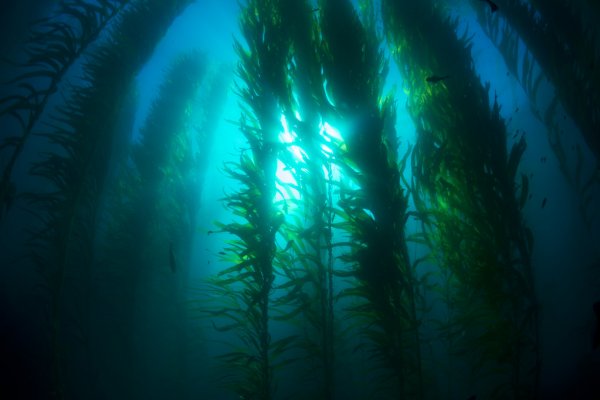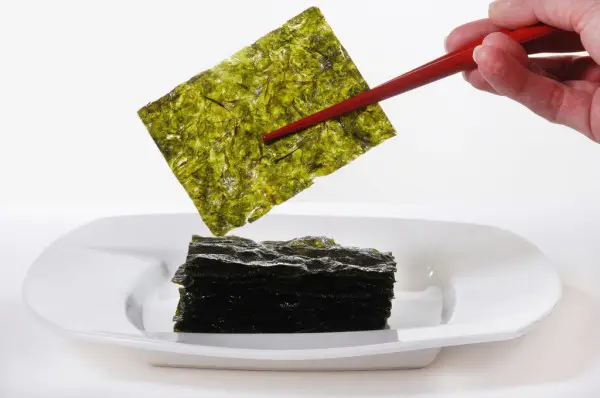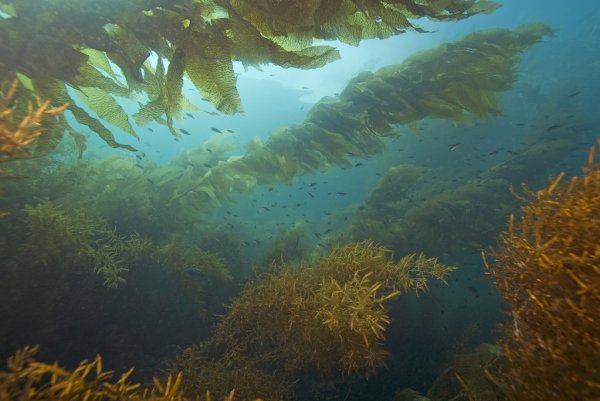What is Seaweed and Why Do Saltwater Fish Eat it?
First off, you might be surprised to learn that seaweed is not truly a plant in the sense of a tree or shrub. It is actually a kind of multicellular algae that forms giant branching structures! Unlike most species of terrestrial plants, seaweed is much more simple in its structure.
In fact, they are close in form to some of the first plants that ever lived, which gave rise to terrestrial plants! We usually think of seaweed as being mostly green, but there are also red, purple, gold, and brown algae that form seaweed colonies.

Seaweed is found mostly in coastal regions where sunlight can reach the depths. Since most seaweed has a holdfast to attach to coral and rocks, they need solid ground and sunlight! Coastal regions are also home to a wide variety of fish species as well. Saltwater fish of all kinds can use it as a food source.
Seaweed is high in iodine, calcium, magnesium, polysaccharides, and fatty acids that herbivorous fish, invertebrates like sea urchins, and even humans need in their diet. If you’ve ever seen or eaten sushi, then you’ve already experienced seaweed in Japanese cuisine. The material used to wrap sushi is called nori, which is a pressed, dried seaweed wrap that holds the roll together!
What Do Fish Eat?
Herbivores, Carnivores and Omnivores
Herbivores are the most common marine fish that eat seaweed. Seaweed can be easily found and even grows into thick forests, such as the kelp forests of the Pacific Ocean and the Sargasso Sea of the Atlantic Ocean. Any animal that eats exclusively plants can be called a herbivore. Herbivorous fish that you can find at aquarium stores include Tangs, many Angelfish, Lawnmower Blennies, and Rabbitfish.
Omnivores are the next dietary group. Watch out when reading other fish care guides because the word “omnivorous” is readily misused. People sometimes think “omnivorous” means that a fish will eat anything you offer it, like pellets, flakes, and frozen foods. Guides might classify a Betta fish as “omnivorous” simply because it won’t turn down whatever you drop in the tank. Bettas are carnivores, by the way, and have a digestive system that’s too short to properly break down plants for their nutritional value.
In reality, omnivorous fish eat both plants and animals to varying degrees. In fact, we humans are a prime example of an omnivorous species. Omnivorous fish include Damselfish and Pygmy Angelfish. Feeding omnivores is easy so long as we make sure to offer plant-based foods alongside protein. Fortunately, there are many ways to feed seaweed to pet fish, which we will discuss below!
Last, there are carnivores, which need to eat meat to survive. We often think of predators like Sharks and Tuna, but even small fish that eat only plankton or animal protein are considered carnivorous, including Mandarin Gobies and Royal Grammas. A carnivorous fish should not eat seaweed; they won’t be able to digest it properly, nor will they obtain the right nutrients.
Do Invertebrates Eat Seaweed?
Yes! In fact, keeping species that eat seaweed is one of the best ways to control algae in aquariums! Common algae eaters include hermit crabs, shrimp, crabs, snails, and sea urchins. Many of these invertebrates also feed on detritus, including leftover fish food. But they should still be given algae and seaweed since it contains far more essential vitamins and minerals.
How Can I Feed My Fish Seaweed?
If you have Tangs, Blennies, Angelfish, and other herbivorous and omnivorous fish that eat seaweed, then you’ll need to provide a source of it so they can obtain the right nutrients.
Seaweed is by far the best source of vitamins and minerals that’s identical to what saltwater fish can find in the wild. Nori is inexpensive and very convenient to have on hand. You will just need a plastic clip to keep it submerged. Eventually, the nori will soften over a short period, and your fish can pick it into manageable pieces.
While all animals with a herbivorous diet should be given vegetables, they are especially important for Tangs. When fed improperly, Tangs develop a disease known as Hole in the Head (HITH) or Lateral Line Disease. While it’s not entirely understood how this occurs, there is a strong correlation between diet and hold in the head in Tangs.

If not fed seaweed, deep pits start to form in their head and the lateral line that runs along their flank in a long strip of scale indentations. Eventually, the disease is fatal if left untreated. Fortunately, HITH can be mostly or entirely reversed if their diet is corrected to include vegetables!
But what if you live in an area where actual seaweed is hard to find? In this case, small pieces of terrestrial vegetables like spinach, kale, zucchini, and many other types of green food can also be used. Just make sure that you parboil these items briefly before feeding in order to soften them enough to be easily chewed and better digested by fish.
Nori does have a single minor downside: it is composed exclusively of red algae in the Polyphora genus. Offering nori is much better than not offering any seaweed at all, but many saltwater herbivores thrive on variety. That’s why I recommend adding dried seaweed supplemental blends that contain Sea Lettuce, Laver, Caulerpa, and other kinds for a nutritional boost.
Feeding Freshwater Aquarium Fish Seaweed
Just because seaweed is found exclusively in saltwater regions of the world doesn’t mean that it’s off-limits for freshwater fish. In fact, it is just as great a food source for them and should be included in the diet of omnivorous and herbivorous fish as often as possible.
Which Freshwater Aquarium Fish Eat Seaweed?
There are many fish that will enjoy seaweed being offered to them! Some of the most common include Mollies, Guppies, Platies, Barbs, and Goldfish. These fish are all omnivorous, with Mollies being almost true herbivores. African cichlids in the Mbuna group are mostly herbivores and love being offered full-sized sheets of seaweed like dried nori.
Remember, seaweed is actually a larger form of algae (macroalgae), which makes it perfect for many species of algae-eating herbivorous fish. Even larger fish like fully grown Koi, Silver Dollars, Plecostomus, and Pacus will gladly devour a full sheet of nori. Greens are required to help food flow completely through the longer digestive system of these fish. The vitamins and especially minerals contained in vegetation are great immune system boosters as well.
Offering seaweed can also help prevent other species of herbivorous fish from eating all of your plants. Many vegetarians will love to eat your soft, decorative plants like Cabomba and Elodea. But if you keep them full of cheaper, more convenient seaweed, then many fish will spare your aquatic garden!
In Summary, What Fish Eat Seaweed?

Aquarium fish from both saltwater and freshwater environments love being offered seaweed. And if you keep snails, shrimp, crabs, and other aquarium invertebrates, then you should take a close look into the food they prefer.
Make sure you feed vegetables to your fish every few days as possible in the form of seaweed, nori, and other sources of healthy ocean greens. The health benefit is undeniable!
Fish keeping FAQs:


